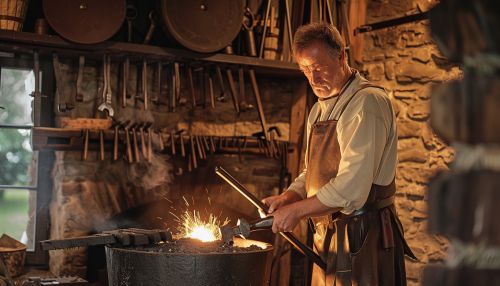Blacksmith
History
The history of blacksmithing dates back to the early Iron Age, when primitive man first began to use iron to make tools and weapons. The term "blacksmith" itself comes from the black fire scale, a layer of oxides that forms on the surface of the metal during heating. The "smith" part comes from the old English word "smið", which means "to strike". Therefore, a blacksmith is one who strikes black metal.


Tools and Equipment
A blacksmith uses a variety of tools and equipment in his work, the most important of which is the forge. The forge is a type of hearth used for heating metals. The metal becomes soft and pliable when heated, allowing the blacksmith to shape it using a hammer and anvil. Other tools used by a blacksmith include tongs to hold the hot metal, and a variety of hammers and chisels to shape and cut the metal.
Techniques
Blacksmiths use a variety of techniques to shape and form metal. These include forging, where the metal is heated and hammered to the desired shape, and welding, where two pieces of metal are heated until they reach a molten state, then joined together. Other techniques include annealing, where the metal is heated and then cooled slowly to soften it, and quenching, where the metal is heated and then rapidly cooled to harden it.
Materials
While blacksmiths traditionally worked with iron, today they work with a variety of metals including steel, copper, bronze, and even gold and silver. Each metal has its own properties and requires different techniques to work with. For example, steel is a very hard and durable metal that requires high temperatures to work with, while copper is much softer and can be worked with at lower temperatures.
Modern Blacksmithing
While the traditional role of the blacksmith has largely been replaced by industrial manufacturing, there is still a demand for skilled blacksmiths. Today, blacksmiths often work as artists or craftsmen, creating decorative items such as gates, railings, and furniture. Some blacksmiths also work in restoration, helping to preserve historical buildings and artifacts.


